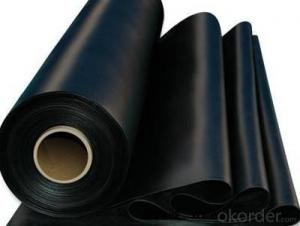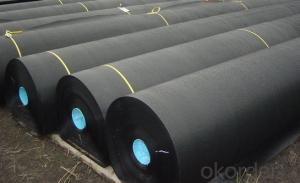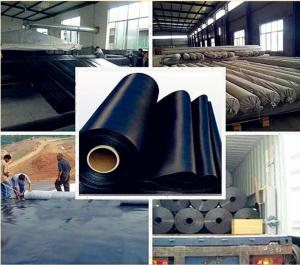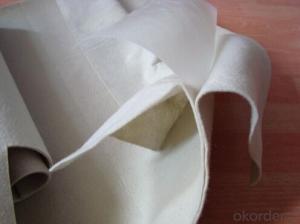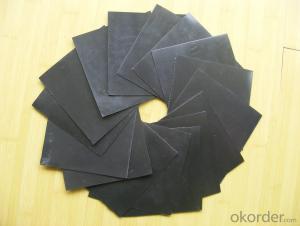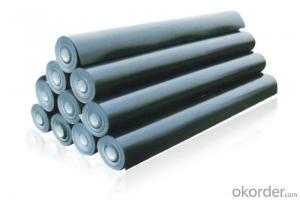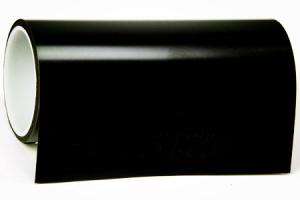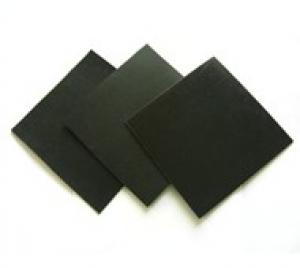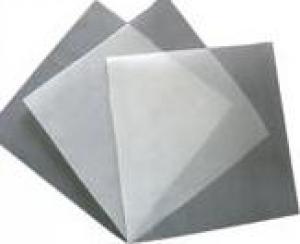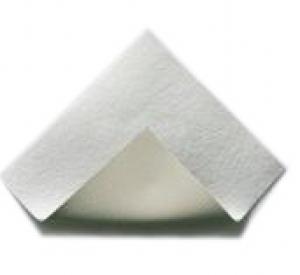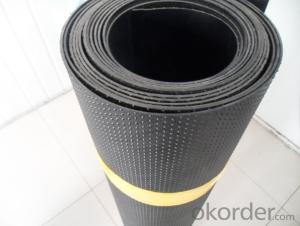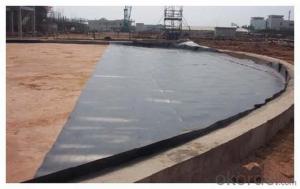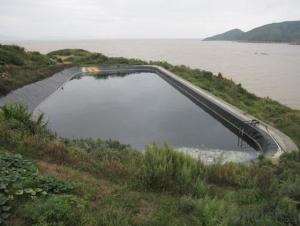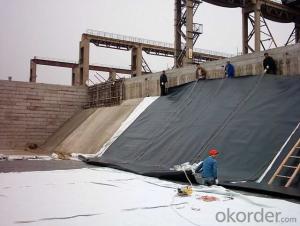1.5mm LLDPE Geomembrane for Road Construction
- Loading Port:
- China main port
- Payment Terms:
- TT OR LC
- Min Order Qty:
- 10000 m²
- Supply Capability:
- 5000000 m²/month
OKorder Service Pledge
OKorder Financial Service
You Might Also Like
1.5mm LLDPE Geomembrane, Find Details about LLDPE Geomembrane and Make an Inquiry for Geomembrane at OKorder.com.
1. LLDPE Geomembrane Specifications
1) Thickness : 0.15mm - 4.0mm.
2) Width : Within 8 m (1m-8m).
3) Length : 50m-100m/roll (as request).
4) Material : LLDPE,( HDPE, LDPE, PVC, EVA, etc ).
5) Color : Black , white , red , blue , or as required.
6) Optional surface : Textued(one or two side) or smooth surface.
7) Certificate:CE/ISO9001,14001
2. LLDPE Geomenbrane Features
Good mechanical properties, high tear strength, deformation and adaptable, puncture resistance, anti-aging, anti-ultraviolet-resistant, Anti oil and salt, pH, anti-corrosion, high temperature-resistant, non-toxic, long service life. water, drainage, seepage, the good effect of moisture, width, thickness of the full range of specifications and low cost, simple construction.
3. LLDPE Geomembrane Applications
1) Environmental protection, sanitation (such as solid waste landfills, sewage treatment plants, power plants Chi-conditioning, industrial, hospital solid waste, etc.) .
2) Water (such as rivers, lakes and reservoirs of the anti-dam, plugging, reinforcement of the canal seepage, the vertical wall of the heart, slope protection, etc.).
3) Municipal Engineering (subway, on the ground floor of the building, planted roof, the roof garden of anti-seepage, sewage pipes lining, etc.).
4) Landscape (man-made lake, river, reservoir, golf courses reservoirs of the substrate, slope protection, green lawn of the waterproof moisture, etc.).
5) Petrochemical (chemical plants, oil refineries, gas storage tanks of the anti-chemical reaction tanks, sedimentation tanks of the lining, etc.).
6) Mining (washing and pool heap leaching, the ash-field, dissolved, precipitation, the yard, the tailings seepage substrates, etc.) .
4. LDPE Geomembrane Show

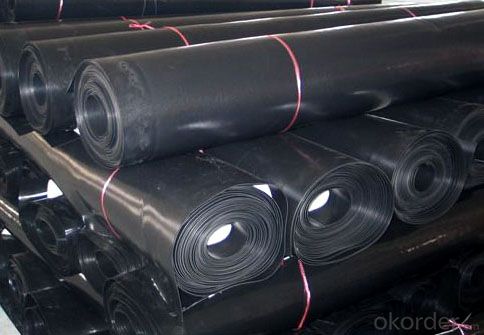
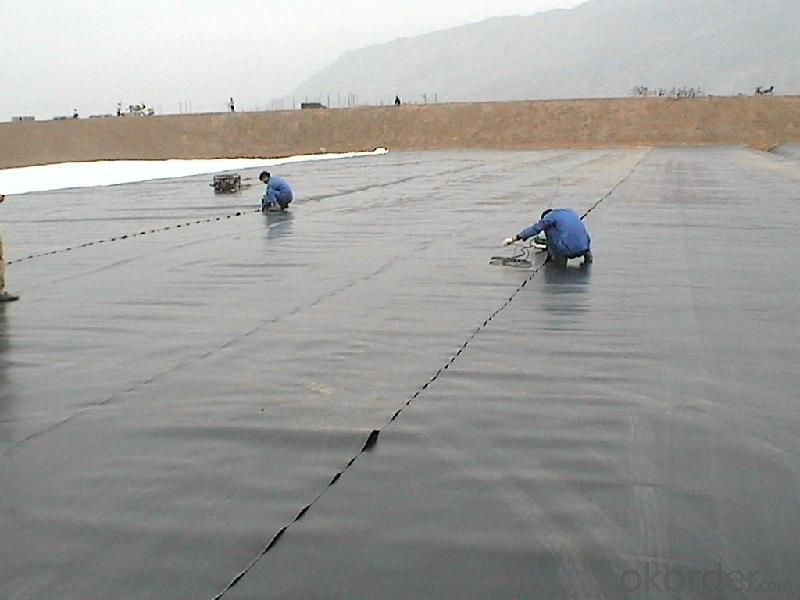

LLDPE Geomembrane RFQ:
1. What are we supplying?
We are specialized in producing .geotextile , geocell, geogrid, geomembrane
2. How Many years experience do we have?
We have been exported to more than 15 countries in the past 10 years.
3. How long do we usually reply your request?
We always reply our customer within 12 hours.
If you want to find more details about the LLDPE Geomembrane, you could make an Inquiry in okorder.com. Okorder.com provides you the products with best price and quality!
- Q:Can geomembranes be used in mining tailings management?
- Yes, geomembranes can be used in mining tailings management. They are commonly utilized as liners or covers in tailings storage facilities to prevent seepage and protect the surrounding environment from contamination. Geomembranes provide a barrier between the tailings and the underlying soil, reducing the risk of water pollution and facilitating the safe storage and management of mining waste.
- Q:Are geomembranes suitable for use in hydroelectric power plants?
- Yes, geomembranes are suitable for use in hydroelectric power plants. They are commonly used in various applications within hydroelectric power plants, such as lining reservoirs, canals, and tunnels. Geomembranes provide effective containment, preventing seepage and leakage of water, which is crucial for the efficient operation of hydroelectric power plants. Additionally, geomembranes are durable, resistant to chemicals and UV degradation, and can withstand the high pressures and temperatures associated with hydroelectric power generation.
- Q:What are the safety considerations for working with geomembranes?
- When working with geomembranes, there are several safety considerations to keep in mind. Firstly, it is important to wear appropriate personal protective equipment (PPE) such as gloves, safety glasses, and steel-toed boots to protect against potential hazards. Secondly, workers should be trained on proper handling and installation techniques to minimize the risk of accidents or injuries. This includes understanding how to safely handle and transport geomembrane rolls, as well as using proper tools and equipment for installation. Additionally, it is crucial to assess the work area for potential hazards such as uneven surfaces, sharp objects, or nearby machinery. Clearing the area of any potential dangers and ensuring proper signage and barricades are in place can help prevent accidents. Furthermore, working with geomembranes may involve the use of adhesives, solvents, or hot air guns. It is important to follow manufacturer's instructions and guidelines for the safe use of these materials, including proper ventilation and storage. Lastly, regular inspections and maintenance of equipment and tools should be carried out to ensure they are in good working condition. This can help prevent malfunctions or accidents during the installation process. Overall, prioritizing safety through proper training, the use of PPE, hazard assessments, and adherence to guidelines and protocols is essential for working with geomembranes.
- Q:What is a coated glass?
- It is to coat a film on top of the surface of the glass. There are many kinds of coated glass to be chosen.
- Q:What are the potential long-term effects of geomembrane use on the environment?
- The potential long-term effects of geomembrane use on the environment can include soil contamination, alteration of natural water flow patterns, disruption of ecosystem dynamics, and potential harm to aquatic life. Geomembranes can impede the natural percolation of water, leading to increased runoff and soil erosion. They can also act as barriers, preventing the exchange of nutrients and gases between the soil and atmosphere, potentially affecting plant growth. Additionally, the use of geomembranes can disrupt the habitat of various species, including aquatic organisms, by altering water flow patterns and blocking migration routes. However, the extent of these effects depends on the specific application, maintenance practices, and overall environmental context.
- Q:What are the standards and regulations governing geomembrane use?
- The standards and regulations governing geomembrane use vary from country to country. However, some widely recognized standards include ASTM International's ASTM D4437 for polyethylene geomembranes and ASTM D7176 for flexible nonreinforced geomembranes for water containment. In addition, organizations like the Geosynthetic Institute (GSI) provide guidelines and recommendations for geomembrane design, installation, and testing. These standards and regulations aim to ensure the quality, performance, and environmental safety of geomembranes in various applications such as waste containment, water management, and mining.
- Q:what is the difference of wallpaper crystal clear film?
- Crystal film (also known as Display film, color film) is a new concept of home decoration materials, it is simple and convenient form of stick membrane, used on the floor tile, furniture, glass, all kinds of table and household appliances. Unique gum technology, easy to use, not shovel the wall, not ground-breaking, directly attached and using immediately, and it can be pasted on cement walls; it doesn't burn when firing, and it does not soak when in water, with affordable price and good effect; it can make changes with cost only thousand yuan. It has six functions, thousands of styles, suitable for all kinds of people's interest, covering finish, decorative and other aspects. functions: Color decoration home protection energy-saving, scientific thermal insulation acoustic noise insulation, fire retardant wallpaper, also called wallpaper, or English as wallcoverings or Wallpaper, it is an application of a wide range of interior decoration materials. Because wallpaper has the features of various colors, rich patterns, luxurious style, convenient and safe, environmental protection, easy to construct, affordable, which many other interior decorative materials can not match, so it gains a considerable popularity in Europe, America, Japan and other developed countries and regions. Wallpaper can be divided into many categories, such as film mulching wallpaper, coated wallpaper, embossed wallpaper. Usually bleached chemical pulp production base paper, and then put into the processing of different processes, such as coating, printing, embossing or surface plastic coated, and finally, after cutting, packaging and transported from factory. Because it has a certain strength, toughness, attractive appearance and good water resistance, it is widely used in homes, offices, guesthouses, hotels and other interior finish.
- Q:Why the drain-pipe below rubber dam base plate is covered with geomembrane?
- Geomembrane, generally refers to water-impermeable material. Geotextiles, generally refers to the permeable material. It is frequently seen that drain-pipe is wrapped with geotextile. It is also seen that the upper part of drain-pipe is wrapped with geotextile, while lower part is wrapped with geomembrane. It is rarely seen that outside the drain-pipe is all wrapped with geomembrane. Because it is more reasonable and convenient that we can use unwrapped tube wall and impermeable tube.
- Q:can the national standard quality of composite geo-membrane be used for geotextile?
- no. composite geomembrane and geotextile are two different products, their function is not the same. Non-woven geotextile is woven into nets with long silk or short silk through different equipments ans technology, needling technology will make different fibers interwoven together, interwoven them and make the fabric standardization, making the fabric soft, rich, thick, hard to make different thickness satisfy the usage requiremants, non-woven geotextile has good fabric gaps and adhesive force, fibers are soft and has tear-resistance performance, also good deformation adaptability, good surface dewatering, it's surface is soft and multi-gap, also good friction coefficient, which will increase the adhesive force of soi particles, it can prevent little particles, losing surplus water while preventing the loss of particles, soft surface has good protective ability. it is divided into long fiber nonwoven geotextile filament or staple fiber nonwoven geotextile in accordance with the length, They can play a very good filtering, isolation, reinforcement, protection function and is a kind of widely used geosynthetics material.
- Q:What are the different thickness options for geomembranes?
- The thickness options for geomembranes typically range from 0.5mm to 3.0mm, depending on the specific application and requirements.
1. Manufacturer Overview |
|
|---|---|
| Location | |
| Year Established | |
| Annual Output Value | |
| Main Markets | |
| Company Certifications | |
2. Manufacturer Certificates |
|
|---|---|
| a) Certification Name | |
| Range | |
| Reference | |
| Validity Period | |
3. Manufacturer Capability |
|
|---|---|
| a)Trade Capacity | |
| Nearest Port | |
| Export Percentage | |
| No.of Employees in Trade Department | |
| Language Spoken: | |
| b)Factory Information | |
| Factory Size: | |
| No. of Production Lines | |
| Contract Manufacturing | |
| Product Price Range | |
Send your message to us
1.5mm LLDPE Geomembrane for Road Construction
- Loading Port:
- China main port
- Payment Terms:
- TT OR LC
- Min Order Qty:
- 10000 m²
- Supply Capability:
- 5000000 m²/month
OKorder Service Pledge
OKorder Financial Service
Similar products
New products
Hot products
Hot Searches
Related keywords
